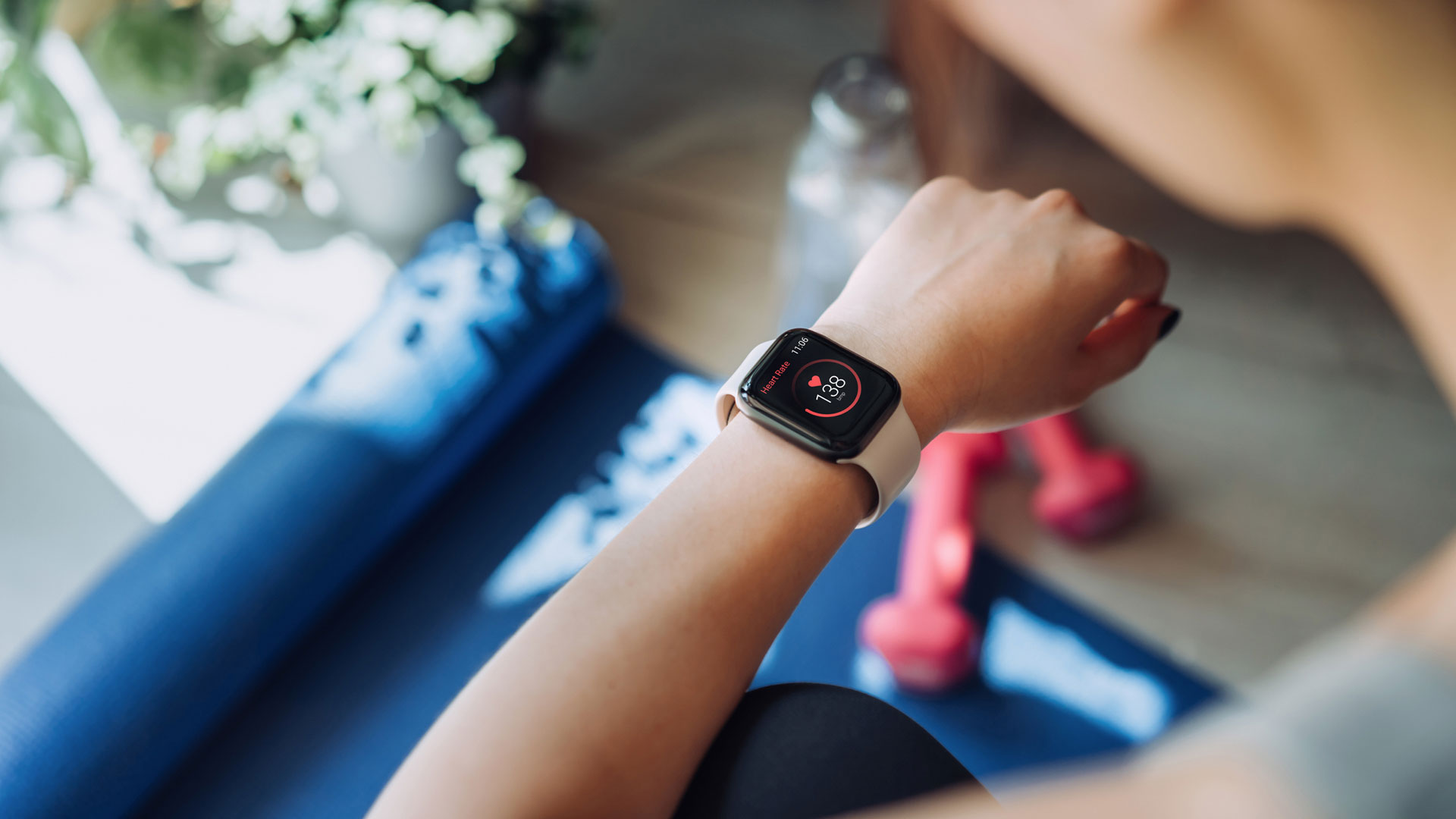What are cardio heart rate zones?
Find out how heart rate training can maximize your workouts, by understanding cardio heart rate zones.

Cardio heart rate zones are a feature of many exercise programs, but what are they and how can they help you get fitter? Whether you're going for a steady run or increasing your stroke rate on a rowing machine, exercise that gets your heart pumping improves cardiorespiratory fitness, builds stamina and burns calories.
Some of the best fitness trackers will track your heart rate for you – but there's some debate how how accurate these tools are.
In this article, we look at the role of heart rate during exercise and explain how training within cardio heart rate zones can improve fitness levels – along with ways to include them in your cardio workouts. Find out about heart rate variability, or read on for key information on cardio heart rate zones, and the science behind it, so you can get in the zone.
What should your heart rate during exercise be?
Heart rate increases during physical activity, meaning the heart performs more beats per minute to meet the demand of delivering oxygenated blood around the body and to the working muscles. According to the American Heart Association (AHA), there are many long-term health benefits associated with regular exercise that elevates the heart rate, including improved circulation, lower blood pressure, lower levels of 'bad' cholesterol, and a reduced risk of heart disease and stroke.

The heart is a muscle, and conditioning it to work more effectively with exercise also lowers your resting heart rate (RHR), which is a marker for good health. A normal RHR for adult men and women ranges between 60-100 beats per minute and a 2013 study published in Heart Journal found that an elevated RHR is not only an indicator of poor physical fitness, but a risk factor for mortality.
Using heart rate as a training metric is an effective method to improve health and fitness – and it's not a new concept. According to the American Council on Exercise (ACE), it's an accurate way to gauge how hard the body is working during exercise in order to get the associated cardiovascular benefits, without putting a strain on your system.
As explained by the MayoClinic, the higher the intensity of exercise, the higher your heart rate, but training within heart rate zones enables you to prescribe consistent, measured effort to a workout. This means you can elevate your heart rate to a specific level, for a set amount of time, depending on your goals and current fitness levels.
Get the world’s most fascinating discoveries delivered straight to your inbox.
As mentioned above, you can monitor your heart rate with the best budget fitness trackers, but these are likely to give general estimates rather than completely accurate readings.
What are cardio heart rate zones?
Omar Mansour, a fitness trainer for WithU, told Live Science: "Cardio heart rate zones are ranges based on percentages of your maximum heart rate (MHR), which is the maximum number of beats your heart can make per minute during exercise before it is under stress."

There are five cardio heart rate zones that are categorized in exercise intensity from lowest (1) to highest (5):
Zone 1: 50-60% of MHR
This zone requires the least amount of effort and may be used for a warm-up and cool-down, or for active recovery sessions. When exercising for longer periods of time at low-intensity (LISS cardio) you would typically be in the upper end of this zone. "It is a good range for improving overall health prior to exercising in the higher heart rate zones," said Mansour.
Zone 2: 60-70% of MHR
Also known as the 'temperate zone'. "Physical activity at 60-70% helps to build endurance and takes the body into fat-burning mode – in this zone, 85% of the calories you burn are from fat," explained Mansour. When remaining in the lower end of the range, it is possible to sustain exercise for longer.
Zone 3: 70-80% of MHR
This is the optimum zone for improving fitness and building muscle strength. Exercise at 70-80% of MHR is aerobic, meaning the body uses oxygen for fuel rather than other energy sources. It is an effective heart rate zone for improving cardiorespiratory capacity – the ability to take in and deliver more oxygen around the body, so over time enables you to exercise for longer.
Zone 4: 80-90% of MHR
"Short, intense bursts of exercise in this zone is considered anaerobic exercise – the process where the body uses glucose stored in the muscles for fuel, rather than oxygen," explained Mansour. "Anaerobic exercise helps to build lean muscle mass, increases the body's resistance to lactic acid build up, boosts metabolism and increases speed and power."
According to the ACE, anaerobic training also enhances excess post-exercise oxygen consumption (EPOC) effect, meaning you continue to burn calories during the post-exercise recovery period.
Zone 5: 90% + of MHR
"Exercise drills in this zone are incredibly challenging – and can only be sustained for up to a few minutes, if not seconds, at a time," said Mansour. Elite athletes train in this zone to increase fast twitch muscle fibres which develops speed.
- Related: Low-impact cardio workout ideas
What is the target cardio heart rate zone?
Your target heart rate is the range of numbers indicating how fast your heart should be beating during moderate to high-intensity physical activity – think of it as the sweet spot so you get the benefits without burning out. According to the AHA, this is roughly 50-70% of your MHR during moderate-intensity exercise, and 70-85% of your MHR during vigorous exercise.
"Your target heart rate zone is dependent on various factors such as your age, the type of activity you are doing, and your overall fitness goals, but generally for most cardio a good place to aim for is the 60-80% category," confirmed Mansour.

To determine your target heart rate, the first step is to calculate your MHR. The Centers for Disease Control and Prevention (CDC) suggest using this simple method:
220 – your age = MHR in beats per minute (bpm)
"Once you know your maximum heart rate you can work out your heart rate ranges in beats per minute for each training zone," explained Mansour.
Here's how to calculate this, using an example of 30 year old exercising at 70-80% of their MHR:
MHR = 190 (220 – 30)
70% (0.7) x 190 = 133
80% (0.8) x 190 = 152
Target heart rate = 133-152 bpm
To monitor your heart rate during exercise, use a fitness tracker to ensure you are hitting your target heart rate zone.
How should you do cardio for heart health?
Government guidelines advise that all adults should do at least 150 minutes of moderate-intensity, or 75 minutes of vigorous-intensity, aerobic exercise per week and Mansour told LiveScience that "including a good variety of intensity zones in your exercise program will make sure your heart is in peak condition."
A 2019 review article published in the Department of Physiology and Cell Biology, confirmed that challenging the heart with physical activity decreases cardiovascular risk factors and improves cardiovascular function by inducing changes in oxygen delivery, vasculature, peripheral tissues, and inflammation.

"Cardiovascular exercise such as running, using a rowing machine, or cycling will all work your heart to pump blood around the body," said Mansour. When performing these for at least 30 minutes you should aim for 60-70% of your MHR. "If you are doing a shorter, faster workout then you want to be hitting the 70-80% cardio heart rate zone and above to ensure you are pushing yourself hard enough. During intense HIIT (high-intensity interval training) sessions then you will inevitably peak well above this, with your heart rate falling again during the recovery periods." Challenging workouts in the upper zones can be balanced with low-intensity exercise where your heart rate remains at 50-60% of MHR – such a long walk.
"If you are consistent, you'll find that your resting heart rate will drop over time. This is an indication that your fitness is improving, and your body is finding exercise easier," added Mansour.
If you have health concerns, talk to your doctor before starting a fitness plan. It's also important that regardless of the number on your heart rate monitor, you should stop if you feel dizzy or have chest pains at any point during exercise.
Ali Horsfall has almost 15 years of experience as a journalist and has written for national print titles and lifestyle brands including woman&home, Woman, Woman's Own, BBC magazines, Mothercare, Grazia and The Independent. She currently specializes in health and fitness content and loves sharing the best expert advice on staying well.



